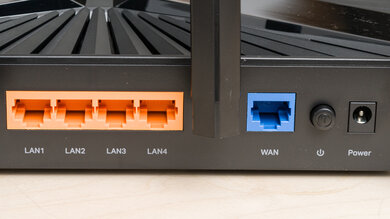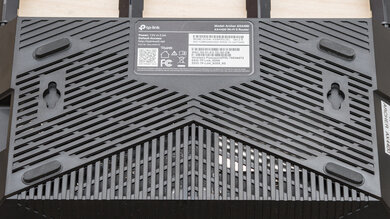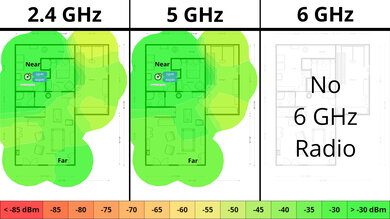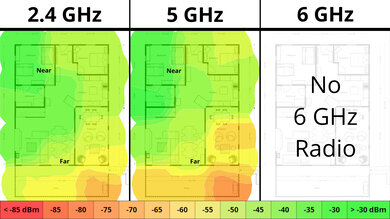The TP-Link Archer AX4400 is a dual-band Wi-Fi 6 router with 2.4GHz and 5GHz bands. It has six external antennas and supports the 160MHz bandwidth. Like most of TP-Link's current routers, it supports WPA3 security and OneMesh technology, allowing you to configure a mesh network with one of TP-Link's Wi-Fi extenders. You can set up and manage the router using TP-Link's Tether app or the web interface, where you can also configure parental controls.
Our Verdict
The TP-Link AX4400 is good if you live in an apartment, condo, or single-story home. It delivers speeds suitable for downloading large files quickly or having multiple users streaming 4k content across a single floor. It also supports Dynamic Frequency Selection (DFS), so it can use less congested DFS-only channels to give you better speeds in noisy wireless environments. It's an average-sized router and has screw head slots on the bottom so you can mount it to a wall or the ceiling.
-
Very fast top speeds.
-
Bulky design with many external antennas make it hard to fit into living spaces.
-
Wi-Fi 6 won't take full advantage of new Wi-Fi 6E or 7 devices.
The TP-Link AX4400 is very good if you live in a multi-level house. It has good coverage and delivers fast speeds suitable for high-bandwidth use, like downloading and uploading large files quickly throughout a home with multiple stories. Since it's a standalone router, its speed drops linearly the farther you are from it. Still, since it's compatible with TP-Link's OneMesh, you can add range extenders to create a mesh network.
-
Impressive range suitable for single- or multi-level homes.
-
Very fast top speeds.
-
Compatible with EasyMesh and OneMesh devices to create a mesh network with better range.
-
Bulky design with many external antennas make it hard to fit into living spaces.
-
Wi-Fi 6 won't take full advantage of new Wi-Fi 6E or 7 devices.
This router delivers very good speeds suitable for an internet connection of up to ~700 Mbps. It also supports Dynamic Frequency Selection (DFS), so it can use less congested DFS-only channels to give you better speeds in noisy wireless environments. That said, it's only Wi-Fi 6, so it doesn't have a faster 6GHz band for your Wi-Fi 6E or 7 devices to take advantage of.
-
Very fast top speeds.
-
Wi-Fi 6 won't take full advantage of new Wi-Fi 6E or 7 devices.
This router has an impressive range for a standalone unit. You can also add a compatible OneMesh range extender for better coverage.
-
Impressive range suitable for single- or multi-level homes.
-
Compatible with EasyMesh and OneMesh devices to create a mesh network with better range.
-
Wi-Fi 6 won't take full advantage of new Wi-Fi 6E or 7 devices.
Changelog
- Updated May 01, 2025: We've converted this review to Test Bench 0.8.1. This includes a new test result for our Test Configuration box.
-
Updated Feb 20, 2025:
Added mention of the TP-Link Archer BE230 as an alternative with 2.5Gbps ports in the Network ports section.
- Updated Jul 22, 2024: Review published.
Check Price
Differences Between Sizes And Variants
The TP-Link AX4400 doesn't have any variants. Here's a photo of our unit's label.
Compared To Other Routers
The TP-Link AX4400 is a dual-band Wi-Fi 6 router in a mid-range price bracket. It supports the 160MHz bandwidth, which, if your device supports it, doubles the maximum bandwidth compared to most Wi-Fi 6 routers. It also has a USB 3.0 port for sharing files with your local network.
Performance-wise, this router is comparable to other Wi-Fi 6 routers in its price bracket, like the ASUS RT-AX3000.
For more recommendations, check out the best Wi-Fi 6 routers, the best Wi-Fi routers, or the best routers for streaming.
The ASUS RT-AX3000 is a better router than the TP-Link Archer AX4400. They're both dual-band Wi-Fi 6 routers, but the ASUS has better signal strength and delivers faster speeds than the TP-Link, especially at further distances. Both routers still deliver speeds suitable for multiple users watching 4k video concurrently.
The TP-Link Archer BE230 and the TP-Link Archer AX4400 are both budget routers. The BE230 is slightly better for smaller spaces, as it has faster short-range speeds; however, the AX4400 is better for large homes, as it has better range. Both routers have five network ports; the BE230 has two ports that support up to 2.5Gbps speeds, while the AX4400 only has 1Gbps ports.
Test Results
Check out the TP-Link Archer BE230 if you want a similar router with 2.5Gbps WAN and LAN ports.
Here's a picture of the USB port located on the side of the router.
This is a standalone router, so the mesh satellite position line on this graph isn't applicable.
This is a standalone router, so the mesh satellite position line on this graph isn't applicable.
Comments
TP-Link Archer AX4400: Main Discussion
Let us know why you want us to review the product here, or encourage others to vote for this product.
Update: We’ve converted this review to Test Bench 0.8.1. This includes a new test result for our Test Configuration box.















